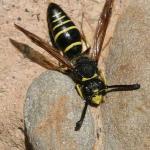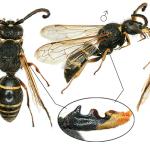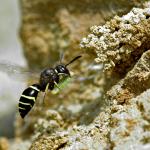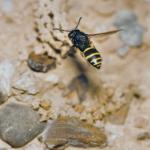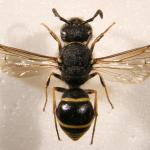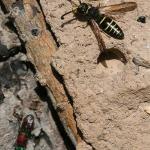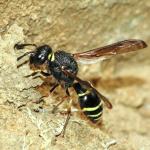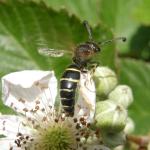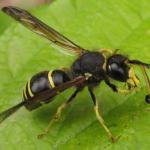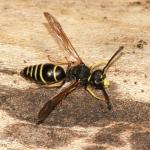Identification keys, distribution and general biology are given in Nielsen (1932), Spradbery (1973), Richards (1980), Falk (1991), and Yeo and Corbet (1995).
Odynerus spinipes is distributed throughout much of England and Wales and reaches southern Scotland. It is also found on the Isle of Man and on Guernsey and Herm in the Channel Islands. There are two old records from Ireland.
This species is not regarded as being threatened.
Adults are most likely to be seen in flight in June but also during July. More unusually they may be seen during the second half of May and early August.
Beetle larvae of the genus Hypera (Curculionidae). During malaxation (chewing) of their prey, the adults also will take the oozing body fluids (Bristowe, 1948).
Mating takes place shortly after the adults emerge, followed by a search for nest sites and preparation and mass provisioning of the cells by the females. Nest sites are in vertical banks of hard earth, often of clay but also of sand. The digging spot is wetted with water and a cluster of five to six cells is excavated just behind the vertical face of the bank (Bristowe, 1948). The excavated material is first used to build a 'chimney' up to 30 mm long which curves over and downwards. The function of the chimney is unknown but it could prevent the entry of rain into the burrows which are situated in rather exposed situations. It has also been suggested that the chimney deters potential cleptoparasites and parasitoids. Several females may be found nesting close together in small aggregations, probably due to lack of suitable nesting site habitat.
The female hunts for beetle larvae over the appropriate vegetation. When found, the prey is immobilised by stinging and malaxation. The prey is carried in the mandibles with the help of the forelegs against the underside of the body. Up to about 30 beetle larvae have been found in a cell. The egg, which is suspended from the wall of the cell by a fine filament, is laid before the prey is collected and hatches in a few days. The prey is eaten by the mason wasp larva in a matter of weeks; the probable overwintering stage is the prepupa.
Those with a short corolla and accessible nectaries are usually chosen. Extra-floral nectaries and honeydew of aphids may also be taken.
The parasitic wasp Chrysis viridula usually acts as a cleptoparasite, entering either the unsealed cell, or removing the partition of a provisioned cell and laying its egg. The larva on hatching destroys the host's egg before eating the prey. However, it may also act as a parasitoid feeding on the mature larva of its host. Other species of Chrysis, Pseudospinolia neglecta and Pseudomalus auratus may be found at O. spinipes nests.
1997


